Implement MSA in a virtualized enterprise environment
Virtualization has become the number one topic in modern IT. According to VMware, server virtualization in Russia grew in 2014 to 30%, doubling in three years. As a result, server utilization is increased: according to various estimates, their average load factor is now from 50% to 80%, which means a decrease in the need for physical servers. Not surprisingly, virtualization technology is increasingly being used not only by large companies and organizations, but also by small businesses. First of all, we are talking about server virtualization.
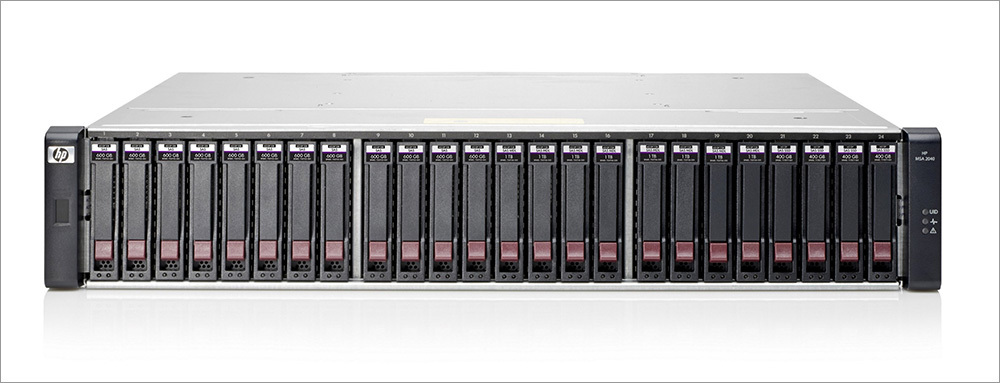
Virtualization provides significant advantages not only in large data centers with hundreds of virtual machines, but also when several VMs are running on the same server. Among them - the benefits of server consolidation, ease of deployment, easy and convenient allocation of resources and standardization of equipment, getting rid of the "zoo" systems. Ultimately, all this translates into lower IT costs and lower total cost of ownership ( TCO ).
Meanwhile, when implementing virtualization, the critical question is the choice of storage systems. Virtualization increases the load on the storage system, therefore, before its implementation, planning, proper selection of the disk array is necessary. Storage should not become a bottleneck in a virtual environment with high requirements for I / O performance and latency. For the successful deployment of server virtualization, this is even more important than the processor power and server RAM capacity.
Small companies that solve server virtualization and storage consolidation tasks need reliable, but at the same time inexpensive and easy to maintain storage systems. HP offers these customers MSA Series entry-level disk arrays. They are designed for businesses with a limited budget who want to get the most out of their IT investments.
MSA is one of the most successful HP disk arrays. More than 400 thousand arrays of the MSA family have already been sold in the world, which are considered one of the best entry-level storage systems on Fiber Channel. These storage systems provide high performance, reliability and ease of management, are well suited for companies representing small and medium-sized businesses (SMB). HP MSA 1040 and MSA 2040 Arrayscan be managed from within Windows Server 2012, which is an added plus since the Windows platform is often used in small organizations.
MSA supports a large number of virtual environments, allows you to consolidate heterogeneous IT resources and, in combination with virtualization, increase their efficiency. According to HP statistics, in 60% of installations MSA arrays are deployed in a virtual environment, which speaks for itself. Four times higher MSA performance compared to the previous generation of these SAN disk arrays means that the system can support more VMs, and the response time in applications is reduced. The performance of the MSA 1040 is 29,000 IOPS, and the MSA 2040 is 82,000 IOPS for random reads, and the throughput is 3.1 and 6.2 GB / s, respectively.
Due to their performance and functionality, the HP MSA 1040/2040 arrays provide a solution that deserves attention when planning the deployment of virtual environments, especially when combined with HP ProLiant servers . Model 1040 is a suitable option for the first virtualization project, and the 2040 array can be used to deploy high-performance virtual environments in companies that have already gained some experience working with virtual servers. HP MSA offers features that simplify the management, deployment and support of the virtual environment, as well as providing the necessary services for working with data.
Small and medium-sized companies, as well as large corporations, are constantly forced to look for ways to reduce costs. Over the past decade, storage technologies have significantly increased the efficiency and flexibility of storage. However, until recently, these improvements were implemented only in disk arrays of the middle and senior classes, which made them inaccessible to small and medium-sized businesses.
At the end of 2014, HP introduced software updates for MSA arrays with advanced virtualization features.- New software reduces the cost of data storage and significantly simplifies management. Updates include dynamic data optimization features, increased productivity through the use of SSD flash drives, and intelligent storage automation using the fourth-generation capabilities of HP MSA hardware architecture.
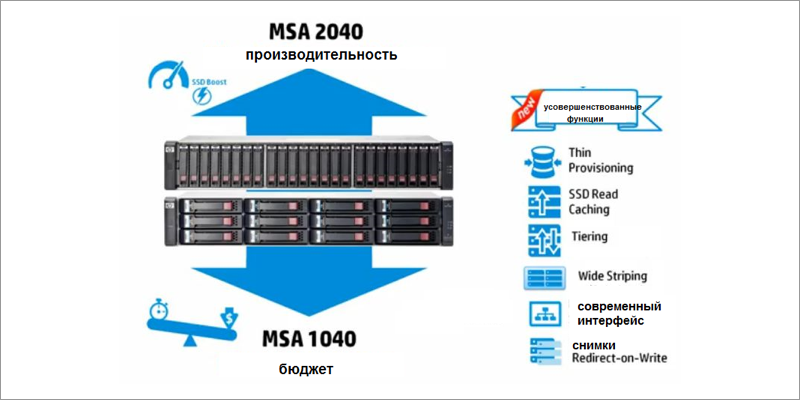
Advanced MSA virtualization features: Thin Provisioning (dynamic allocation of capacities), SSD Read Cache (read cache on solid state drives), Automated Tiering (automatically moving data across storage tiers), Redirect on Write Snapshot (data snapshots with redirection during writing) and Wide striping(virtual pool with distribution by HDD).
Thin Provisioning
This feature provides flexible capacity utilization and expansion as needed. Thin Provisioning - creating logical volumes that initially use a little space and “grow” as data is written to them. Dynamic allocation of disk space allows you to quickly allocate storage resources to virtual servers and eliminate the reservation of a larger capacity than necessary. Thin Provisioning is supported by popular server virtualization environments , and according to VMware, its performance impact is negligible.
Thin Provisioning means reducing storage costs that would otherwise have to be allocated in excess. Administrators can allocate large virtual volumes to applications - even with excess physical capacity. Actually, the VM uses as much disk space as it needs at the moment. The system itself warns the administrator that it will soon require the purchase of additional capacity. Another useful feature is the “thin rebuild” of RAID (Thin Rebuild), when only already allocated blocks are involved in the reorganization process after a RAID failure or a change in the RAID level. This significantly reduces the time of this procedure.
It is also important to note that, unlike the HP StoreVirtual line, MSA supports not only dynamic allocation, but also capacity deallocation (T10-Unmap): the system releases data blocks after receiving a file delete command from the file system. It is important for the effective use of Thin Provisioning.
SSD caching
The SSD Read Cache feature available in the MSA 2040 (MSA 1040 does not support SSD) means that you can cache data on solid state drives when reading. MSA supports the installation of up to two SSD drives up to 1.6TB in capacity as a read cache. SSD Read Cache improves storage performance for random reads. In the laboratory, during read operations, the response time of the disk system improves to 80%, which is reflected in a noticeable acceleration of the virtual environment.
Automatic tiered storage
This feature allows you to optimize the use of expensive SSD drives - they store “hot” data that is often accessed, that is, data with the largest number of read / write operations. Automated Tiering moves hot blocks (4 MB pages) to fast SSDs, which speeds up operations with them. “Archive tearing” works similarly: rarely used (“cold”) data is moved from SAS disks to slower MDL SAS disks. Tiering helps to find the optimal balance between the cost of the system and its performance. According to HP, automatic tiering saves 70-80% in dollars per gigabyte. Tearing and read cache are complementary technologies in the approach to working with data: the read cache works almost instantly and allows you to speed up the work during the period of so-called “bursts of activity”,

As tiering storage levels, SAS disks of different classes (in MSA 1040) or SAS and SSD (in MSA 2040) can be used.
Wide Striping
This feature actually means virtualizing storage resources within the MSA. It allows you to organize existing physical disks into a storage pool and use their capacity to create virtual disks (V-disk). In this case, the V-disk can be distributed throughout the pool. The previous limitation of 16 physical disks per virtual disk is removed, the volume capacity is increased. By distributing the virtual disk across physical drives, performance is improved, i.e. A virtual volume can use the disk resources of all disks used in the pool.

Wide Striping improves disk utilization and reduces response time by distributing V-disk volume data across all disks.
Improving the data snapshot mechanism
More efficient snapshot functions simplify management and improve backup performance, enabling disaster recovery in more complex cases. Snapshots in the new release now work on the principle of Redirect-on-Write, which improves the performance of operations compared to traditional Copy-on-Write (fewer back-end I / O are required). Simplified image setup.

The new MSA firmware version has the ability to create “snapshots”, which is used by software developers to debug versions.
Improved Web-based interface and improved management
Updated management interface, now uses HTML5 as a platform. The new interface simplifies and speeds up administration, especially in a server virtualization environment, where management can be complicated by the rapid increase in the number of VMs, and reduces the likelihood of errors. The sorting, searching, filtering, and grouping functions make it easy to manage a large number of hosts and volumes. You can also manage MSA arrays directly from popular virtual environment management systems, for example, in VMware vCenter — create logical volumes (LUNs), assign them to servers, etc.
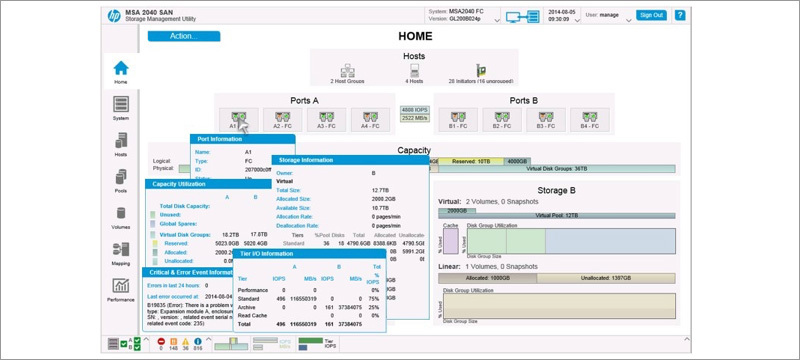
New SMU (Storage Management Utility) interface.
What does Microsoft Exchange virtualization do? Such an environment is easy to scale by allocating resources (for example, memory and processor power) to virtual machines. More efficient use of equipment reduces operating costs, including the cost of power, cooling, storage infrastructure, and storage administration. Increased system reliability: virtualization allows administrators to create Database Availability Groups (DAGs) and use Exchange database replication tools with minimal hardware resources. You can configure the fault tolerance level of the entire Exchange architecture and protect yourself from the failure of system components. In addition, you can update the software without disconnecting users from the mail server.
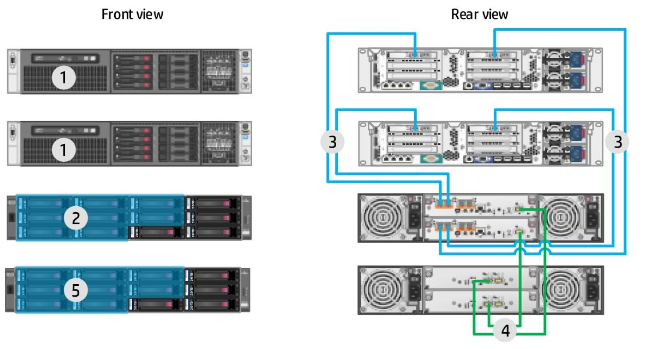
An example of a reference architecture for deploying an Exchange virtual environment (front and back views):
1. Two HP ProLiant DL380p Gen8 servers.
2. An array of HP MSA 2040 with 8 2 TB SAS LFF disks allocated for Exchange databases and logs. The remaining disks are used as backup.
3. The primary and secondary connection FC 16 Gb / s.
4. Primary and secondary SAS 6 Gb / s.
5. The disk shelf of HP MSA 2040 LFF with 8 disks 2 TB SAS LFF allocated for Exchange databases and logs.
The HP MSA 2040 can be scaled to increase the number of users by connecting disk enclosures. Two system controllers operating in active / active mode, dual-port drives and redundant components reduce the likelihood of storage failure to a minimum. The HP MSA 2040 also allows you to select different connection options to meet your SAN configuration requirements. Built-in tools simplify array deployment and administration.
Exchange 2013 virtualization guidelines are available at Microsoft .
When virtualizing Microsoft Exchange 2013 using Microsoft Hyper-V and HP MSA 2040 arrays, you can host additional virtualized applications on the same server. For example, HP ProLiant DL380p Gen8 Serverit can handle not only the Exchange load, but also serve other virtual servers. Reducing the number of physical servers simplifies administration and reduces the cost of support.
Microsoft Exchange on HP ProLiant and HP MSA Storage is a cost-effective, reliable, and scalable messaging solution. In the Microsoft Windows Server 2012 Hyper-V virtual environment on ProLiant DL380p Gen8 servers with HP MSA 2040 disk arrays, you can support about 750 Exchange 2013 mailboxes.
A suitable example of use is the use of the MSA 2040 array for SQL server 2012, where the MSA 2040 array is good proved to be working with loads of sequential and random reading and writing.
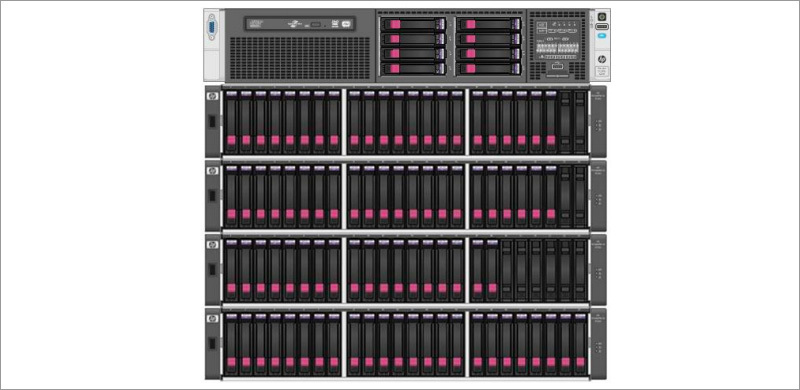
MSA 2040 Reference Architecture for SQL Server 2012
HP MSA 1040/2040 Arrays are the right solution for deploying a virtual environment in SMB. These systems have sufficient flexibility, are easy to manage / administer, and allow you to choose the best option for cost or performance.
Read on:
" Best practices for working with arrays MSA 1040/2040
" Capacity up to 1.2GB / s to the MSA array
" Best practices for working with MSA array in VMware environments
Our previous publications:
" Disk Arrays the HP MSA as a basis for consolidation of data
" Multivendor corporate network: myths and reality
"Available HP ProLiant Server Models (Series 10 and 100)
» HP Networking Convergence. Part 1
» HP ProLiant ML350 Gen9 - server with incredible extensibility
Thank you for your attention, we are ready to answer your questions in the comments.

Virtualization in SMB
Virtualization provides significant advantages not only in large data centers with hundreds of virtual machines, but also when several VMs are running on the same server. Among them - the benefits of server consolidation, ease of deployment, easy and convenient allocation of resources and standardization of equipment, getting rid of the "zoo" systems. Ultimately, all this translates into lower IT costs and lower total cost of ownership ( TCO ).
Meanwhile, when implementing virtualization, the critical question is the choice of storage systems. Virtualization increases the load on the storage system, therefore, before its implementation, planning, proper selection of the disk array is necessary. Storage should not become a bottleneck in a virtual environment with high requirements for I / O performance and latency. For the successful deployment of server virtualization, this is even more important than the processor power and server RAM capacity.
Small companies that solve server virtualization and storage consolidation tasks need reliable, but at the same time inexpensive and easy to maintain storage systems. HP offers these customers MSA Series entry-level disk arrays. They are designed for businesses with a limited budget who want to get the most out of their IT investments.
MSA is one of the most successful HP disk arrays. More than 400 thousand arrays of the MSA family have already been sold in the world, which are considered one of the best entry-level storage systems on Fiber Channel. These storage systems provide high performance, reliability and ease of management, are well suited for companies representing small and medium-sized businesses (SMB). HP MSA 1040 and MSA 2040 Arrayscan be managed from within Windows Server 2012, which is an added plus since the Windows platform is often used in small organizations.
MSA supports a large number of virtual environments, allows you to consolidate heterogeneous IT resources and, in combination with virtualization, increase their efficiency. According to HP statistics, in 60% of installations MSA arrays are deployed in a virtual environment, which speaks for itself. Four times higher MSA performance compared to the previous generation of these SAN disk arrays means that the system can support more VMs, and the response time in applications is reduced. The performance of the MSA 1040 is 29,000 IOPS, and the MSA 2040 is 82,000 IOPS for random reads, and the throughput is 3.1 and 6.2 GB / s, respectively.
Due to their performance and functionality, the HP MSA 1040/2040 arrays provide a solution that deserves attention when planning the deployment of virtual environments, especially when combined with HP ProLiant servers . Model 1040 is a suitable option for the first virtualization project, and the 2040 array can be used to deploy high-performance virtual environments in companies that have already gained some experience working with virtual servers. HP MSA offers features that simplify the management, deployment and support of the virtual environment, as well as providing the necessary services for working with data.
HP MSA Advanced Features
Small and medium-sized companies, as well as large corporations, are constantly forced to look for ways to reduce costs. Over the past decade, storage technologies have significantly increased the efficiency and flexibility of storage. However, until recently, these improvements were implemented only in disk arrays of the middle and senior classes, which made them inaccessible to small and medium-sized businesses.
At the end of 2014, HP introduced software updates for MSA arrays with advanced virtualization features.- New software reduces the cost of data storage and significantly simplifies management. Updates include dynamic data optimization features, increased productivity through the use of SSD flash drives, and intelligent storage automation using the fourth-generation capabilities of HP MSA hardware architecture.

Advanced MSA virtualization features: Thin Provisioning (dynamic allocation of capacities), SSD Read Cache (read cache on solid state drives), Automated Tiering (automatically moving data across storage tiers), Redirect on Write Snapshot (data snapshots with redirection during writing) and Wide striping(virtual pool with distribution by HDD).
Thin Provisioning
This feature provides flexible capacity utilization and expansion as needed. Thin Provisioning - creating logical volumes that initially use a little space and “grow” as data is written to them. Dynamic allocation of disk space allows you to quickly allocate storage resources to virtual servers and eliminate the reservation of a larger capacity than necessary. Thin Provisioning is supported by popular server virtualization environments , and according to VMware, its performance impact is negligible.
Thin Provisioning means reducing storage costs that would otherwise have to be allocated in excess. Administrators can allocate large virtual volumes to applications - even with excess physical capacity. Actually, the VM uses as much disk space as it needs at the moment. The system itself warns the administrator that it will soon require the purchase of additional capacity. Another useful feature is the “thin rebuild” of RAID (Thin Rebuild), when only already allocated blocks are involved in the reorganization process after a RAID failure or a change in the RAID level. This significantly reduces the time of this procedure.
It is also important to note that, unlike the HP StoreVirtual line, MSA supports not only dynamic allocation, but also capacity deallocation (T10-Unmap): the system releases data blocks after receiving a file delete command from the file system. It is important for the effective use of Thin Provisioning.
SSD caching
The SSD Read Cache feature available in the MSA 2040 (MSA 1040 does not support SSD) means that you can cache data on solid state drives when reading. MSA supports the installation of up to two SSD drives up to 1.6TB in capacity as a read cache. SSD Read Cache improves storage performance for random reads. In the laboratory, during read operations, the response time of the disk system improves to 80%, which is reflected in a noticeable acceleration of the virtual environment.
Automatic tiered storage
This feature allows you to optimize the use of expensive SSD drives - they store “hot” data that is often accessed, that is, data with the largest number of read / write operations. Automated Tiering moves hot blocks (4 MB pages) to fast SSDs, which speeds up operations with them. “Archive tearing” works similarly: rarely used (“cold”) data is moved from SAS disks to slower MDL SAS disks. Tiering helps to find the optimal balance between the cost of the system and its performance. According to HP, automatic tiering saves 70-80% in dollars per gigabyte. Tearing and read cache are complementary technologies in the approach to working with data: the read cache works almost instantly and allows you to speed up the work during the period of so-called “bursts of activity”,

As tiering storage levels, SAS disks of different classes (in MSA 1040) or SAS and SSD (in MSA 2040) can be used.
Wide Striping
This feature actually means virtualizing storage resources within the MSA. It allows you to organize existing physical disks into a storage pool and use their capacity to create virtual disks (V-disk). In this case, the V-disk can be distributed throughout the pool. The previous limitation of 16 physical disks per virtual disk is removed, the volume capacity is increased. By distributing the virtual disk across physical drives, performance is improved, i.e. A virtual volume can use the disk resources of all disks used in the pool.

Wide Striping improves disk utilization and reduces response time by distributing V-disk volume data across all disks.
Improving the data snapshot mechanism
More efficient snapshot functions simplify management and improve backup performance, enabling disaster recovery in more complex cases. Snapshots in the new release now work on the principle of Redirect-on-Write, which improves the performance of operations compared to traditional Copy-on-Write (fewer back-end I / O are required). Simplified image setup.

The new MSA firmware version has the ability to create “snapshots”, which is used by software developers to debug versions.
Improved Web-based interface and improved management
Updated management interface, now uses HTML5 as a platform. The new interface simplifies and speeds up administration, especially in a server virtualization environment, where management can be complicated by the rapid increase in the number of VMs, and reduces the likelihood of errors. The sorting, searching, filtering, and grouping functions make it easy to manage a large number of hosts and volumes. You can also manage MSA arrays directly from popular virtual environment management systems, for example, in VMware vCenter — create logical volumes (LUNs), assign them to servers, etc.

New SMU (Storage Management Utility) interface.
Virtualization on the example of Microsoft Exchange
What does Microsoft Exchange virtualization do? Such an environment is easy to scale by allocating resources (for example, memory and processor power) to virtual machines. More efficient use of equipment reduces operating costs, including the cost of power, cooling, storage infrastructure, and storage administration. Increased system reliability: virtualization allows administrators to create Database Availability Groups (DAGs) and use Exchange database replication tools with minimal hardware resources. You can configure the fault tolerance level of the entire Exchange architecture and protect yourself from the failure of system components. In addition, you can update the software without disconnecting users from the mail server.

An example of a reference architecture for deploying an Exchange virtual environment (front and back views):
1. Two HP ProLiant DL380p Gen8 servers.
2. An array of HP MSA 2040 with 8 2 TB SAS LFF disks allocated for Exchange databases and logs. The remaining disks are used as backup.
3. The primary and secondary connection FC 16 Gb / s.
4. Primary and secondary SAS 6 Gb / s.
5. The disk shelf of HP MSA 2040 LFF with 8 disks 2 TB SAS LFF allocated for Exchange databases and logs.
The HP MSA 2040 can be scaled to increase the number of users by connecting disk enclosures. Two system controllers operating in active / active mode, dual-port drives and redundant components reduce the likelihood of storage failure to a minimum. The HP MSA 2040 also allows you to select different connection options to meet your SAN configuration requirements. Built-in tools simplify array deployment and administration.
Exchange 2013 virtualization guidelines are available at Microsoft .
When virtualizing Microsoft Exchange 2013 using Microsoft Hyper-V and HP MSA 2040 arrays, you can host additional virtualized applications on the same server. For example, HP ProLiant DL380p Gen8 Serverit can handle not only the Exchange load, but also serve other virtual servers. Reducing the number of physical servers simplifies administration and reduces the cost of support.
Microsoft Exchange on HP ProLiant and HP MSA Storage is a cost-effective, reliable, and scalable messaging solution. In the Microsoft Windows Server 2012 Hyper-V virtual environment on ProLiant DL380p Gen8 servers with HP MSA 2040 disk arrays, you can support about 750 Exchange 2013 mailboxes.
A suitable example of use is the use of the MSA 2040 array for SQL server 2012, where the MSA 2040 array is good proved to be working with loads of sequential and random reading and writing.

MSA 2040 Reference Architecture for SQL Server 2012
HP MSA 1040/2040 Arrays are the right solution for deploying a virtual environment in SMB. These systems have sufficient flexibility, are easy to manage / administer, and allow you to choose the best option for cost or performance.
Read on:
" Best practices for working with arrays MSA 1040/2040
" Capacity up to 1.2GB / s to the MSA array
" Best practices for working with MSA array in VMware environments
Our previous publications:
" Disk Arrays the HP MSA as a basis for consolidation of data
" Multivendor corporate network: myths and reality
"Available HP ProLiant Server Models (Series 10 and 100)
» HP Networking Convergence. Part 1
» HP ProLiant ML350 Gen9 - server with incredible extensibility
Thank you for your attention, we are ready to answer your questions in the comments.
